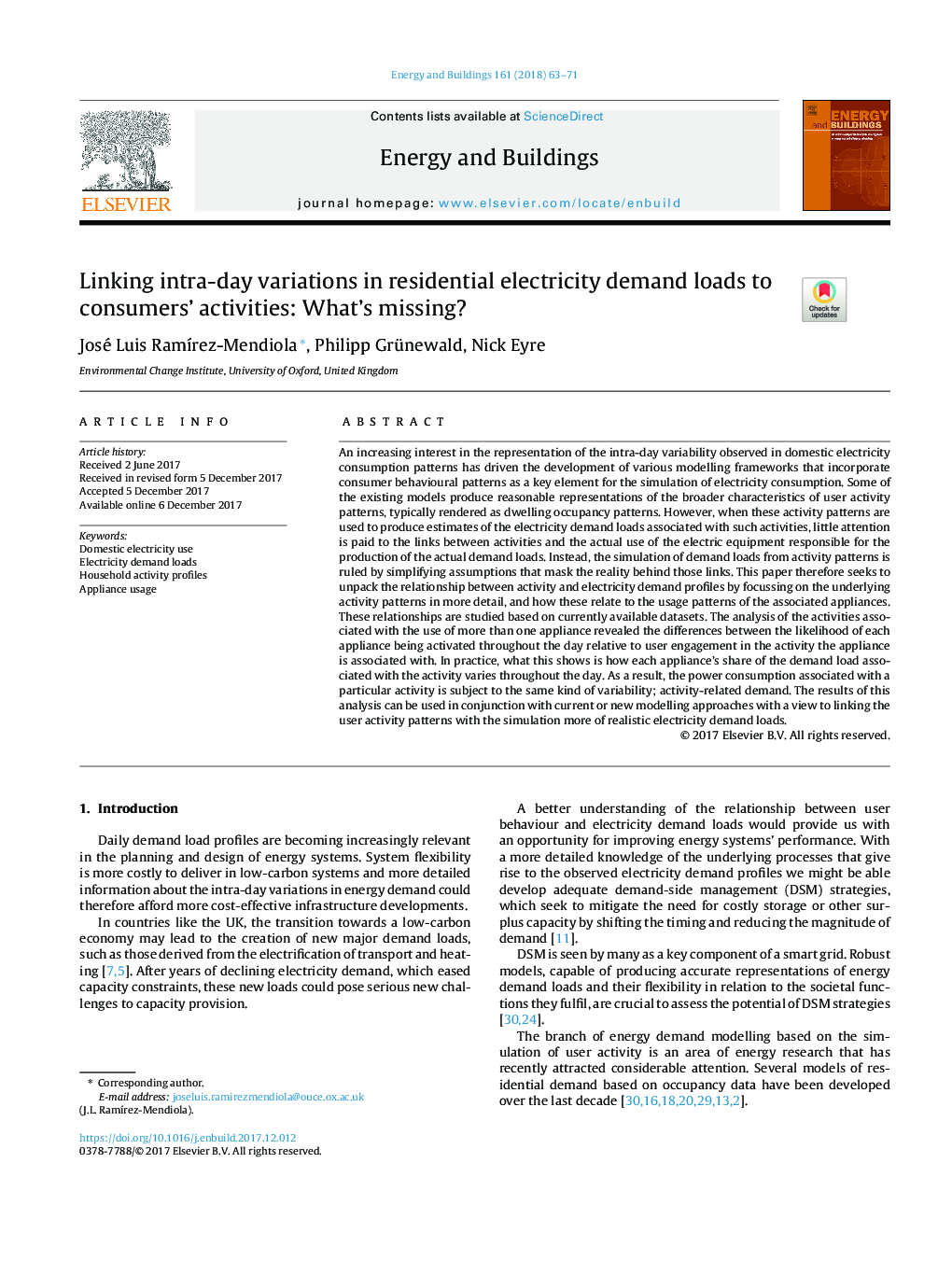| کد مقاله | کد نشریه | سال انتشار | مقاله انگلیسی | نسخه تمام متن |
|---|---|---|---|---|
| 6728997 | 1428929 | 2018 | 9 صفحه PDF | دانلود رایگان |
عنوان انگلیسی مقاله ISI
Linking intra-day variations in residential electricity demand loads to consumers' activities: What's missing?
ترجمه فارسی عنوان
پیوند تغییرات روزانه در بارهای تقاضای برق خانگی به فعالیت های مصرف کنندگان: چه چیزی از دست رفته است؟
دانلود مقاله + سفارش ترجمه
دانلود مقاله ISI انگلیسی
رایگان برای ایرانیان
کلمات کلیدی
استفاده از برق خانگی، بار تقاضای برق، پروفایل فعالیت های خانگی، استفاده از دستگاه،
ترجمه چکیده
علاقه شدیدی به نمایندگی تغییرات روزانه مشاهده شده در الگوهای مصرف برق داخلی منجر به توسعه چارچوب مدل سازی مختلفی شده است که الگوهای رفتاری مصرف کننده را به عنوان یک عنصر کلیدی برای شبیه سازی مصرف برق متصل می کند. برخی از مدل های موجود، بازنمایی معقولی از ویژگی های گسترده تری از الگوهای فعالیت کارکنان را ارائه می دهند که عموما به عنوان الگوی اشغال خانه ها ارائه می شوند. با این حال، هنگامی که این الگوهای فعالیت برای تولید تخمین های بارهای تقاضای برق مرتبط با چنین فعالیت هایی مورد استفاده قرار می گیرد، توجه کمی به ارتباط بین فعالیت ها و استفاده واقعی از تجهیزات الکتریکی مسئول تولید بارهای تقاضای واقعی صورت می گیرد. در عوض، شبیه سازی بارهای تقاضای از الگوهای فعالیت توسط ساده سازی فرضهایی که واقعیت پشت این لینک ها را پنهان می کند، کنترل می شود. به این ترتیب، این مقاله به دنبال کشف رابطه بین فعالیت ها و پروفایل های تقاضای برق با تمرکز بر الگوهای فعالیت های زیربنایی بیشتر و همچنین نحوه ارتباط آنها با الگوهای استفاده از وسایل همراه است. این روابط بر اساس مجموعه داده های موجود موجود است. تجزیه و تحلیل فعالیت های مربوط به استفاده از بیش از یک دستگاه نشان داد تفاوت بین احتمال هر دستگاه فعال در طول روز نسبت به تعامل کاربر در فعالیت با دستگاه مرتبط است. در عمل، آنچه نشان می دهد این است که چگونه سهم هر دستگاه از بار تقاضا در ارتباط با فعالیت متفاوت است در طول روز. به عنوان یک نتیجه، مصرف انرژی مرتبط با یک فعالیت خاص، همان گونه تغییرپذیر است؛ تقاضای مربوط به فعالیت نتایج این تجزیه و تحلیل را می توان در رابطه با رویکردهای مدل سازی فعلی یا جدید با استفاده از مدل سازی فعالیت های کاربر با شبیه سازی بیشتر بارهای واقعی تقاضای برق مورد استفاده قرار داد.
موضوعات مرتبط
مهندسی و علوم پایه
مهندسی انرژی
انرژی های تجدید پذیر، توسعه پایدار و محیط زیست
چکیده انگلیسی
An increasing interest in the representation of the intra-day variability observed in domestic electricity consumption patterns has driven the development of various modelling frameworks that incorporate consumer behavioural patterns as a key element for the simulation of electricity consumption. Some of the existing models produce reasonable representations of the broader characteristics of user activity patterns, typically rendered as dwelling occupancy patterns. However, when these activity patterns are used to produce estimates of the electricity demand loads associated with such activities, little attention is paid to the links between activities and the actual use of the electric equipment responsible for the production of the actual demand loads. Instead, the simulation of demand loads from activity patterns is ruled by simplifying assumptions that mask the reality behind those links. This paper therefore seeks to unpack the relationship between activity and electricity demand profiles by focussing on the underlying activity patterns in more detail, and how these relate to the usage patterns of the associated appliances. These relationships are studied based on currently available datasets. The analysis of the activities associated with the use of more than one appliance revealed the differences between the likelihood of each appliance being activated throughout the day relative to user engagement in the activity the appliance is associated with. In practice, what this shows is how each appliance's share of the demand load associated with the activity varies throughout the day. As a result, the power consumption associated with a particular activity is subject to the same kind of variability; activity-related demand. The results of this analysis can be used in conjunction with current or new modelling approaches with a view to linking the user activity patterns with the simulation more of realistic electricity demand loads.
ناشر
Database: Elsevier - ScienceDirect (ساینس دایرکت)
Journal: Energy and Buildings - Volume 161, 15 February 2018, Pages 63-71
Journal: Energy and Buildings - Volume 161, 15 February 2018, Pages 63-71
نویسندگان
José Luis RamÃrez-Mendiola, Philipp Grünewald, Nick Eyre,
